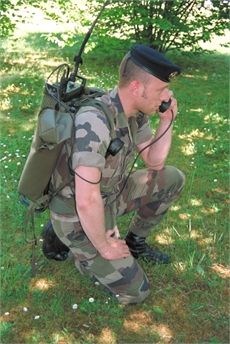ABERDEEN PROVING GROUND, Md. — Employees from the U.S. Army Edgewood Chemical Biological Center’s Smoke and Target Defeat Branch, in support of the Joint Project Manager Nuclear Biological Chemical Contamination Avoidance Obscuration Team, recently hosted more than 50 interested parties during a “proof of concept” demonstration of futuristic, non-lethal battlefield capabilities at the APG’s M‑Field.
The “performance test” demonstrations were pulled together in 90 days ― in collaboration with the U.S. Army Armament Research, Development and Engineering Center, Howe and Howe Technologies, Inc. and Saab South Africa ― and included a manned and unmanned Ripsaw ground vehicle with mounted smart launchers and cutting-edge portable obscurant generators.
“Perhaps more important than the fact that the demonstration was a success is that it has stimulated dialog across industry, multiple Army research development and engineering centers and military organizations to help create clarification of future requirements that will help to save the lives of warfighters,” said Brian McFadden, a systems engineer responsible for coordinating the demonstration.
The collaborative team of defense and industry professionals came together to evaluate potential solutions to satisfy sustainability requirements at the request of the U.S. Army Maneuver Center of Excellence’s leadership to address a capability gap in non-lethal weapons.
While many of the teams were already working on separate pieces of the demonstration, the JPM NBC CA team was responsible for merging efforts, performing tests on obscurant and launcher components of the demonstration, as well as hosting and executing the demo.
“ARDEC has been working with Saab, South Africa, to develop the Multi-Mission Modular Weapon System, which has the capability to fire 40mm, 66mm and 80mm rounds from one common launcher,” McFadden added. “This demonstrates the launcher’s flexibility to use numerous existing rounds of ammunition. It also highlights the capability to use this launcher for both smoke screening and non-lethal missions.”
In addition to the Multi-Mission Modular Weapon System Launcher, the demonstration also included the Ripsaw, a very maneuverable, unmanned/manned armed tank that performs at over 60 MPH, a Screen Obscuration Module prototype, fabricated by the Missouri University of Science and Technology, called the UMR generator and the Multi Spectral Material.
“The bottom line is that mission is to serve the warfighter and smoke obscurants and non-lethal weapons provide battlefield force multipliers that give service members in harm’s way the ability to incapacitate targeted personnel or materiel, while minimizing fatalities,” said Rob Carestia, a mechanical engineer and supervisor in the ECBC Smoke and Target Defeat Branch.
Aiming to build on the success of the “proof of concept” demonstration, the ECBC team plans to continue to work with ARDEC and others to further development and eventually deliver the technologies to theater.
Source:
U.S. Department of Defense
Office of the Assistant Secretary of Defense (Public Affairs)

 von
von 
